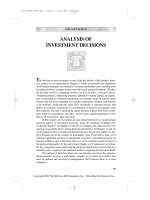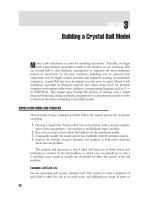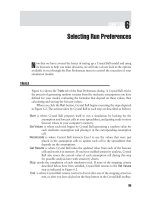Financial Modeling with Crystal Ball and Excel Chapter 8 pptx
Bạn đang xem bản rút gọn của tài liệu. Xem và tải ngay bản đầy đủ của tài liệu tại đây (223.1 KB, 7 trang )
CHAPTER
8
Modeling Financial Statements
P
erhaps the most widely used financial models are the pro forma income statement
and balance sheet. Most companies use deterministic versions of these models
for planning, and they are a natural place to start when constructing a Crystal
Ball model. Especially when decision makers are first exposed to risk analysis with
Crystal Ball, it is best to make your stochastic models resemble as much as possible
the deterministic models to which decision makers in your company are already
accustomed.
In this chapter, we start with deterministic pro forma statements from Chapter 6
of Sengupta (2004), which is an excellent source for more information on construct-
ing deterministic financial models in Excel. In this chapter, we will focus on using
Crystal Ball with an existing deterministic model, just as you might do on the job.
We walk through use of the basic tools to get you started. As you gain experience,
you will be tempted to make your models far more complex than those presented
here. However, do not add complexity just for its own sake. It is far better to start
with a simple model, and add complexity only if necessary to help make a sound
decision.
DETERMINISTIC MODEL
Figure 8.1 shows the historical income statement for 1999–2002 for the Vitex
Corporation example from Chapter 6 of Sengupta (2004). Figure 8.2 shows the
balance sheets for 1999–2002 for the Vitex Corporation. Our job is to project these
measures forward using historical data and input from management about the future
uncertainty.
We begin thinking about the uncertain future by looking to the past. While it is
always true that there are no guarantees the future will resemble the past, historical
data are often the best information you will have available. Furthermore, if you do
have available to you a better source of information about what portends for your
company’s fortunes, then you can easily incorporate it in a Crystal Ball model using
the methodology described here.
Figure 8.3 shows the common size statements for 1999–2002 for the Vitex
Corporation from Sengupta (2004). These are created by dividing each year’s
125
126 FINANCIAL MODELING WITH CRYSTAL BALL AND EXCEL
FIGURE 8.1 Historical income statement in Sengupta.xls.
income statement line items by the corresponding year’s sales so that each line item
in the common size statement is expressed as a percentage of sales. By looking at the
variability of common size line items over the years, we gain an idea of how much
variability to expect in each line item. Then we can quantify the impact of each item
on the bottom line.
TORNADO CHART AND SENSITIVITY ANALYSIS
Figure 8.4 shows a Crystal Ball model for 2002–2006 for the Vitex Corpora-
tion income statement from Sengupta (2004), which we use to create a tornado
and sensitivity chart. Cell J6 models the average changes in sales across years as
a uniform(1%,10%) Crystal Ball assumption based on information provided by
management on the possible variation they see for sales. Cells J7, J10,andJ12
are uniform(48%,52%), uniform(27%,30%), and uniform(−1%,0%) assumptions,
respectively. These parameters were selected based on the common size statements,
and were defined to facilitate use of the tornado chart and sensitivity chart to see
which variables had the greatest impact on the forecast, EBIT in 2006.
Figure 8.5 shows a tornado chart for the Crystal Ball model for 2002–2006 for
the Vitex Corporation income statement from Sengupta (2004). This shows that the
sales forecasting factor had the largest impact, then cost of sales, followed by sales,
general and administrative (SG&A) expenses.
Modeling Financial Statements
127
FIGURE 8.2 Balance sheet in Sengupta.xls.
FIGURE 8.3 Common-size statements in Sengupta.xls.
128 FINANCIAL MODELING WITH CRYSTAL BALL AND EXCEL
FIGURE 8.4 Crystal Ball model for income statement in Sengupta2.xls. Cells J6,
J7, J10,andJ12 are Crystal Ball assumptions, and I3 is a forecast.
FIGURE 8.5 Tornado chart for Crystal Ball model in Sengupta2.xls.
The values of the Crystal Ball assumptions were varied from the 1st
percentile to the 99th percentile in five equally spaced steps.
Modeling Financial Statements
129
FIGURE 8.6 Sensitivity analysis chart for Crystal Ball model
in Sengupta2.xls.
CRYSTAL BALL SENSITIVITY CHART
Figure 8.6 shows a sensitivity chart for the Crystal Ball model for 2002–2006 for
the Vitex Corporation income statement from Sengupta (2004). This chart shows
results similar to those obtained from the tornado chart, but indicates an even larger
impact from the sales forecasting factor. See Chapter 2 for an explanation of the
differences between these two types of charts.
Figure 8.7 shows a Crystal Ball model for 2002–2006 for the Vitex Corpo-
ration income statement from Sengupta (2004). Note that this models the annual
changes in sales and cost of sales as a percentage year-by-year as Crystal Ball
assumptions. In Chapter 11, we look closer at modeling financial time series with
this sort of multiplicative random walk model, and introduce more models for
simulating financial time series.
Figure 8.8 shows a forecast chart for the Crystal Ball model for 2002–2006
for the Vitex Corporation income statement from Sengupta (2004). A 95 percent
certainty interval for earnings before interest and taxes (EBIT) in 2006 is from
$201.5 to $309.2.
CONCLUSION
In modeling financial statements, our intent is to project financial measures into
the future to help make informed decisions about the activities that result in these
130 FINANCIAL MODELING WITH CRYSTAL BALL AND EXCEL
FIGURE 8.7 Crystal Ball model in Sengupta3.xls.
FIGURE 8.8 Forecast chart for Crystal Ball model in Sengupta3.xls.
measures. Deterministic versions of pro forma statements have long been used
for answering ‘‘what-if’’ questions about the bottom-line impact of managerial
decisions, and a Crystal Ball model can be viewed as a type of more-sophisticated
what-if analysis from which decision makers can gain more insight than from a
deterministic model.
Modeling Financial Statements
131
The procedure for modeling financial statements is to identify the key inputs, as
we did with the tornado chart, which varied many inputs one at a time to see the
impact on the key output, EBIT in 2006. Any output may be specified depending
on the decision maker’s interest. Because we used sales-driven forecasting, it is
no surprise that we found sales growth to be the most important driver of 2006
EBIT. This emphasizes the need to come up with a good model for defining sales
assumptions.
We started with common-size statements to see which percentages are stable
over time and which are variable. We usually base our projections on historical
data where they are available, but can incorporate other educated guesses too, if
they are encapsulated in probability distributions that are used to define Crystal Ball
assumptions. When historical data are available, a popular technique is to obtain
subjective estimates from subject matter experts for the parameters of Uniform or
Triangular assumptions.
The procedure for modeling financial statements is to identify the key inputs, as
we did with the Tornado Chart, then observe key outputs like EBIT in 2006. Any
output may be specified depending on the decision maker’s interest. Because we used
sales-driven forecasting, it is no surprise that we found sales growth to be the most
important driver of 2006 EBIT. This emphasizes the need to come up with a good
model for defining sales assumptions.









